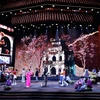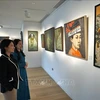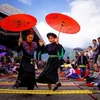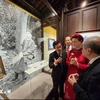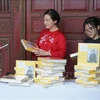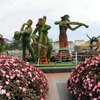Hanoi plans to propose 82 doctoral steles at the Temple of Literature to UNESCO for recognition as world documentary heritage.
“If the steles in the Temple of Literature are recognised, it would be a very significant event for Hanoi to celebrate during its 1,000 th anniversary next year,” Hanoi People’s Committee vice chairwoman Ngo Thi Thanh Hang said at the seminar on Aug. 9.
Achieving recognition would require evidence that the steles were unique compared to those in Hue , Japan and China for their origins and the Confucian values they represent, for their calligraphy and design, and for their influence and significance in Vietnamese culture.
Dang Kim Ngoc, director of the Temple of Literature ’s Culture and Science Centre, said there were many doctoral steles in Hue , Beijing , and Japan , but only Hanoi ’s written epitaphs.
“Almost all there epitaphs honour famous national cultural figures and great scholars, so they are invaluable works that have contributed to the growth of Vietnam ’s tradition of culture and education,” said Ngoc.
The 82 steles at the Temple of Literature date from the 15 th to 18 th centuries and serve as a record of men of outstanding scholastic achievement, 1,306 humanities scholars recognised between 1442 and 1779. Rectangular, with the upper corners rounded off, they stand on pedestals in the form of turtles-a symbol of longevity-heaven (the dome-shaped dorsal carapace) and earth (the square ventral plastron).
Each stele is marked with the year of the competitive examinations, the year it was erected, the names of the laureates and of their native villages (sometimes a few words about their lives), and the names of the calligrapher and carver. The top part displays carvings of dragons and the moon, symbols of equilibrium and harmony between Heaven and Earth, and phoenix (spirit) and clouds (knowledge).
The steles of the 15 th century are plainer in design. Those of the 16 th century are more stylised, and those made in the 17 th and 18 th centuries are more intricately decorated, with threatening dragons paying homage to the moon and phoenix in flight among the clouds.
The one dedicated to the examinations of 1442 also expresses the desire of the king to recruit good servants for the country. “Men of wisdom and talent form the original vital breath of the nation. If this breath is strong, the country is strong; if it weakens, the country weakens. That is why a saintly emperor and enlightened king will make it an urgent task to train talents and look for eminent, learned men and employ them, thus preserving the original vital breath of the nation./.
“If the steles in the Temple of Literature are recognised, it would be a very significant event for Hanoi to celebrate during its 1,000 th anniversary next year,” Hanoi People’s Committee vice chairwoman Ngo Thi Thanh Hang said at the seminar on Aug. 9.
Achieving recognition would require evidence that the steles were unique compared to those in Hue , Japan and China for their origins and the Confucian values they represent, for their calligraphy and design, and for their influence and significance in Vietnamese culture.
Dang Kim Ngoc, director of the Temple of Literature ’s Culture and Science Centre, said there were many doctoral steles in Hue , Beijing , and Japan , but only Hanoi ’s written epitaphs.
“Almost all there epitaphs honour famous national cultural figures and great scholars, so they are invaluable works that have contributed to the growth of Vietnam ’s tradition of culture and education,” said Ngoc.
The 82 steles at the Temple of Literature date from the 15 th to 18 th centuries and serve as a record of men of outstanding scholastic achievement, 1,306 humanities scholars recognised between 1442 and 1779. Rectangular, with the upper corners rounded off, they stand on pedestals in the form of turtles-a symbol of longevity-heaven (the dome-shaped dorsal carapace) and earth (the square ventral plastron).
Each stele is marked with the year of the competitive examinations, the year it was erected, the names of the laureates and of their native villages (sometimes a few words about their lives), and the names of the calligrapher and carver. The top part displays carvings of dragons and the moon, symbols of equilibrium and harmony between Heaven and Earth, and phoenix (spirit) and clouds (knowledge).
The steles of the 15 th century are plainer in design. Those of the 16 th century are more stylised, and those made in the 17 th and 18 th centuries are more intricately decorated, with threatening dragons paying homage to the moon and phoenix in flight among the clouds.
The one dedicated to the examinations of 1442 also expresses the desire of the king to recruit good servants for the country. “Men of wisdom and talent form the original vital breath of the nation. If this breath is strong, the country is strong; if it weakens, the country weakens. That is why a saintly emperor and enlightened king will make it an urgent task to train talents and look for eminent, learned men and employ them, thus preserving the original vital breath of the nation./.





